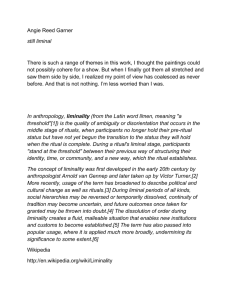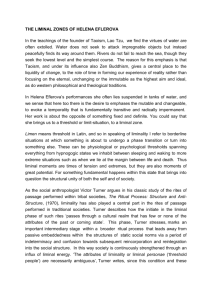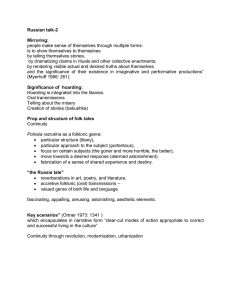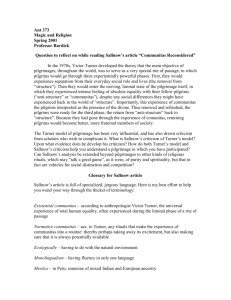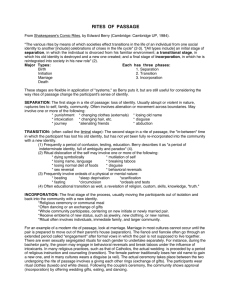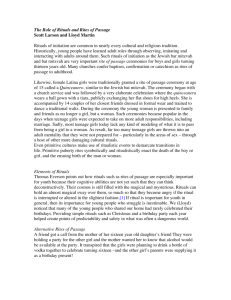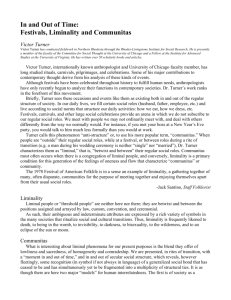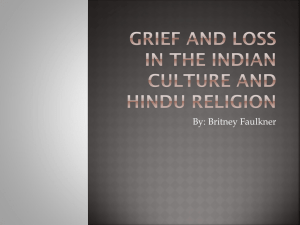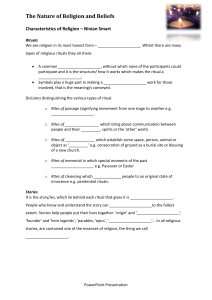Drama- Ritual and Fury
advertisement
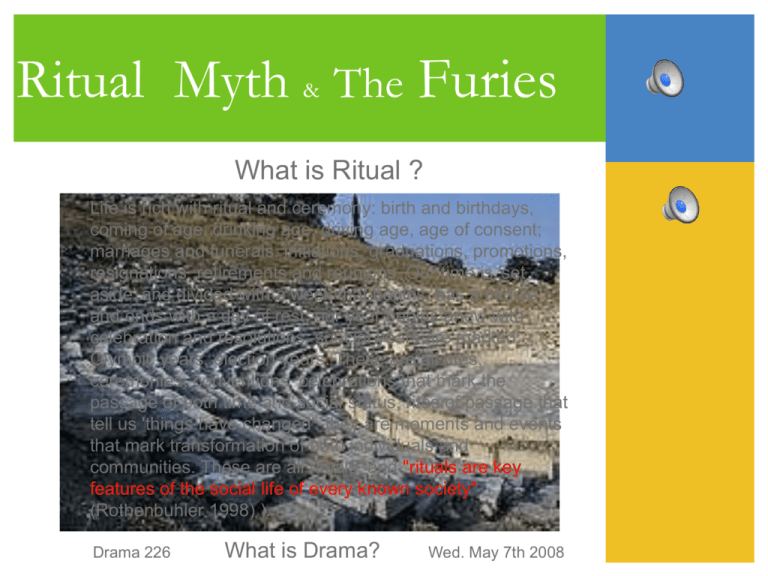
Ritual Myth The Furies & What is Ritual ? Life is rich with ritual and ceremony: birth and birthdays, coming of age: drinking age, driving age, age of consent; marriages and funerals, initiations, graduations, promotions, resignations, retirements and reunions. Our time is 'set aside' and divided with a week that begins, has a middle, and ends with a day of rest; our year begins anew with celebration and resolutions, special years are marked: Olympic years, election years. These are all rites, ceremonies, conventions, celebrations that mark the passage of both time and social status, rites of passage that tell us 'things have changed': they are moments and events that mark transformation of both individuals and communities. These are all rituals, and "rituals are key features of the social life of every known society" (Rothenbuhler 1998) ). Drama 226 What is Drama? Wed. May 7th 2008 How I came to think It began on the Fringes ... bout ritual With the strangest experience .... I need to tell you a little about the Fringe Festivals, first ..... 1981 Edmonton, Brian Paisley jumps on a bar table in the Strathcona pub .....as Fringe myth has it ( and I helped to shape that myth) My quest, I wanted to understand how the arena of a performance effected both the artists and the audience. And by arena I mean the total environment: the social, cultural and architectural spaces of the performances. In short, I wanted to see if ‘theatre’ did anything -- outside of the literary. And this is what I saw ..... Which lead me to read Victor Turner in an effort to understand what it was that I thought I was seeing. Turner was most interested in how people and societies, and indeed, cultures change: transformation. ritual as a social process. culture is a "changing entity, influenced by 'root paradigms,' that is, by axiomatic frames, or deep myths, that propel and transform people and groups at critical moments" culture was a constantly negotiated set of meanings. (1957), he introduced the concept of social dramas A great influence on Turner’s thinking, was van Gennep's work, Rites of Passage (1960, original 1909). Van Gennep, a folklorist, theorized that rites of passage have three principle stages:rites of separation, margin or limen (i.e., threshold), and re aggregation. Turner tossed van Gennep’s theory on rites of passage, like pebble, into the pool of his intellectual questions and watched the ripples grow. He introduced the term multivocality to indicate that one symbol may stand for many things. He suggested three readings, or voices for symbols: indigenous meaning, the operational meaning and the positional meaning. "Liminal entities are neither here nor there; they are betwixt and between the positions assigned (Turner, 1969:95). and arrayed by law, custom, convention, and ceremonial" Liminality is a state of being in between phases. In a rite of passage the individual in the liminal phase is neither a member of the group she previously belonged to nor is she a member of the group she will belong to upon the completion of the rite. Liminality Closely associated to liminality is communitas which describes a society during a liminal period I have used the term "anti-structure,"... to describe both liminality and what I have called "communitas." I meant by it not a structural reversal... but the liberation of human capacities of cognition, affect, volition, creativity, etc., from the normative constraints incumbent upon occupying a sequence of social statuses (1982:44). What I came to call the invisible rules, as I began to see them .... It is the potential of an anti-structured liminal person or liminal society (i.e., communitas) that makes Turner's ideas so engaging. People or societies in a liminal phase are a "kind of institutional capsule or pocket which contains the germ of future social developments, of societal change" (Turner, 1982:45). Social Dramas How I came to think It was 1970, and the first performance I ever went to, on Avenue Road in Toronto was Dionysus 69 . about the ancient greek theatre And then it was 1989 and I was studying theatre in the midst of the academic gender wars. So, naturally ... The chorus asks: Think yet, for what acquittal thou dost plead: He who hath shed a mother's kindred blood, Shall he in Argos dwell, where dwelt his sire? How shall he stand before the city's shrines, How share the clansmen's holy lustral bowl? 48 mythopoesis And Apollo answers: This too I answer; mark a soothfast word Not the true parent is the woman's womb That bears the child; she doth but nurse the seed New-sown: the male is parent; she for him, As stranger for a stranger, hoards the germ Of life, unless the god its promise blight. And proof hereof before you will I set. Birth may from fathers, without mothers, be: See at your side a witness of the same, Athena, daughter of Olympian Zeus, Never within the darkness of the womb Fostered nor fashioned, but a bud more bright Than any goddess in her breast might bear. And I, O Pallas, howsoe'er I may, And the Furies answer ... Woe on you, younger gods! the ancient right Ye have o'erridden, rent it from my hands. I am dishonoured of you, thrust to scorn! But heavily my wrath Why, one might would anyone Shall on this ask, land fling forth the drops that try blastto anddeny burn, the most Venom of fundelmental vengeance, that shall work such scatherelationships? obvious, and of all human As I have suffered; where that dew shall fall, Shall leafless blight arise, Wasting Earth's offspring,-justice, hear my call!And thorough all the land in deadly wise Shall scatter venom, to exude again In pestilence on men. What cry avails me now, what deed of blood, Unto this land what dark despite? Huh ??? The Erinyes Greek myth and thought linked tyrants with women, both because a rule imposed illegitimately on the people (tyranny) prevents the tyrant, who must be guarded and secluded, from indulging in the freedom of movement characteristic of a free man and because tyrants are inevitably tempted to indulge appetites in a fashion characteristic of women and barbarians, both of whom are thought to be naturally undisciplined. Foley, 1998, xviii - xix). Text With the Oresties, Aeschylus exploits these parallel cultural assumptions about women and tyranny. In the second play of the trilogy, The Libation Bearers, Clytemnenstra and Aegisthus rule against the will of the people, Clytemnestra was a tyrant. Have a great weekend
